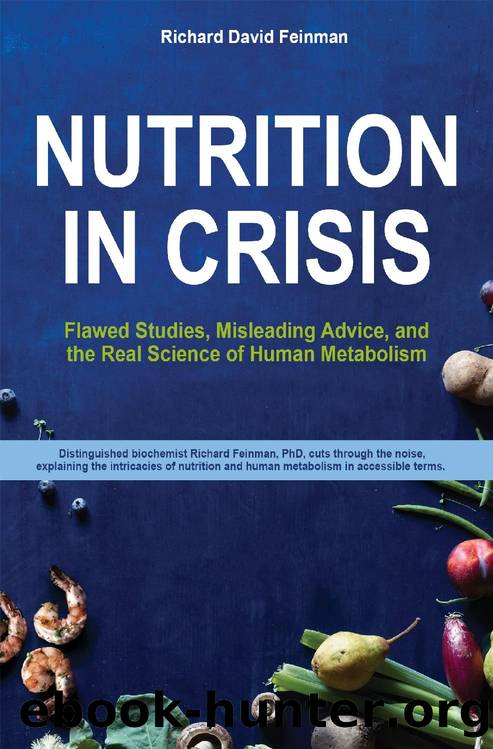Nutrition in Crisis: Flawed Studies, Misleading Advice, and the Real Science of Human Metabolism by Richard David Feinman

Author:Richard David Feinman [Feinman, Richard David]
Language: eng
Format: epub, mobi
Tags: Health & Fitness, Diet & Nutrition, Diets, Nutrition, Diseases, Cancer, Diabetes, Medical, Endocrinology & Metabolism, History
ISBN: 9781603588195
Google: 9oxjvAEACAAJ
Barnesnoble:
Publisher: Chelsea Green Publishing
Published: 2019-03-26T07:00:00+00:00
Beyond âA Calorie Is a Calorieâ 133
4. Several mechanisms, particularly substrate cycling and gluconeogenesis,
are involved. Experimentally, inefficiencies in digestion and metabolic
processing (the so-called thermic effect of feeding) contribute as well.
Many people find metabolic advantage counterintuitive because the
idea of energy conservation has been so deeply ingrained in their minds.
I will explain the fallacy. I will present some of the data and then explain
how the process plays out in terms of biochemical mechanisms.
The Data
There are basically two kinds of diet experiments. Some clearly show
energy balance and some clearly do not. Hereâs an example of the former:
If you take a normal person, keep them in a hospital room, and feed them
constant calories (figure 9.1), you will find that it doesnât matter much how the calories are distributed among different foods. âWide variations in the
ratio of carbohydrate to fat do not alter total 24-h energy needâ2âtheir
weight will stay roughly constant. In some experimental cases, like this, a
calorie is indeed just a calorie. Two people who are roughly similar in age
and health will respond similarly to two isocaloric (same caloric value)
diets regardless of the diet composition (amount of fat, carbohydrate, and
protein). This means that, yes, calories count. Yet there are many exceptions.
The energy balance shown in figure 9.1 is achieved by biologic mecha-
nisms, not the laws of thermodynamics. In those cases, where everything
balances out, it isnât physical laws but rather the unique characteristics of FPO
Days
10
24
38
52
66
80
94 55 W
54 eigh
53 t (kg)
52
51
10% Fat
70% Fat
Figure 9.1. A thirteen-week study of a subject first on 10 percent (75 percent carbohydrate) of energy intake as fat and then on 70 percent (15 percent carbohydrate) of energy intake as fat. From J. Hirsch et al., âDiet Composition and Energy Balance in Humans,â American Journal of Clinical Nutrition 67, no. 3 (1998): 551Sâ555S.
Chelsea Green eGalley. Not for copying or distribution. Quotation with permission only. UNCORRECTED PROOF.
134
Nutrition in Crisis
FPO
A
B
Wk 0
Wk 12
Wk 0
Wk 12
0
0
0
VLCKD
-2
Low Fat
-5
-5
-4
oss (kg)
-10
-10
-6
t L
oss (kg)t L
eighW -8
eigh -15
-15
W
-10
-20
-20
-12
VLCKD
LFD
0
1
2
3 4
5
6
7
8 9 10 11 12
-25
-25
Week
A
B
Wk 0
Wk 12
Wk 0
Wk 12
0
0
0
VLCKD
-2
Low Fat
-5
-5
-4
oss (kg)
-10
-10
-6
t L
oss (kg)t L
eighW -8
eigh -15
-15
W
-10
-20
-20
-12
VLCKD
LFD
0
1
2
3 4
5
6
7
8 9 10 11 12
-25
-25
Week
Figure 9.2. Comparison of low-carbohydrate ketogenic diet and low-fat diet. From J. S. Volek et al., âCarbohydrate Restriction Has a More Favorable Impact on the Metabolic Syndrome than a Low Fat Diet,â Lipids 44, no. 4 (2009): 297â309.
Chelsea Green eGalley. Not for copying or distribution. Quotation with permission only. UNCORRECTED PROOF.
Download
Nutrition in Crisis: Flawed Studies, Misleading Advice, and the Real Science of Human Metabolism by Richard David Feinman.mobi
This site does not store any files on its server. We only index and link to content provided by other sites. Please contact the content providers to delete copyright contents if any and email us, we'll remove relevant links or contents immediately.
| Administration & Medicine Economics | Allied Health Professions |
| Basic Sciences | Dentistry |
| History | Medical Informatics |
| Medicine | Nursing |
| Pharmacology | Psychology |
| Research | Veterinary Medicine |
Bioenergetica by Alexander Lowen(1123)
Noise: A Flaw in Human Judgment by Sunstein Cass R. & Sibony Olivier & Kahneman Daniel(968)
The Data Detective by Tim Harford(945)
The Child in You by Stefanie Stahl(883)
Chatter by Ethan Kross(799)
The Science of Rapid Skill Acquisition by Peter Hollins(639)
Freedom by Sebastian Junger(633)
No Bad Parts by Richard C. Schwartz(604)
The Montessori Baby by Simone Davies(566)
Evolution Gone Wrong: The Curious Reasons Why Our Bodies Work by Alex Bezzerides(560)
The Quantum Psychiatrist: From Zero to Zen Using Evidence-Based Solutions Beyond Medication and Therapy by Biswas Dona(551)
Maps of Meaning: The Architecture of Belief by Jordan B. Peterson(551)
The Science of Self-Learning: How to Teach Yourself Anything, Learn More in Less Time, and Direct Your Own Education (Learning how to Learn Book 1) by Peter Hollins(522)
Anxiety For Dummies by Charles H. Elliott & Laura L. Smith(512)
Sadomasochism and the BDSM Community in the United States by Stephen K. Stein(498)
Disconnected by thomas Kersting(481)
Why Sex Doesn't Matter by Olivia Fane(480)
The Mechanics of Passions: Brain, Behaviour, and Society by Alain Ehrenberg(480)
Jung - The Key Ideas: Teach Yourself (TY Philosophy) by Ruth Snowden(468)
